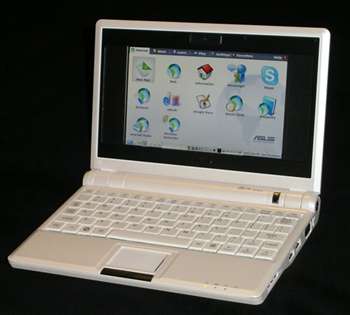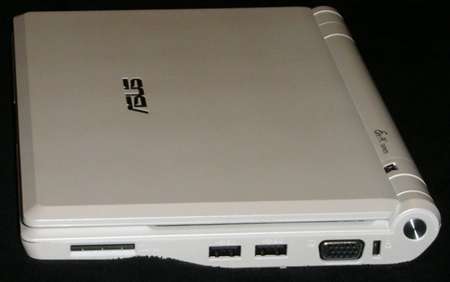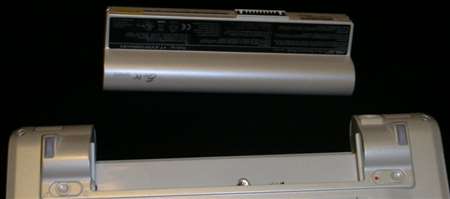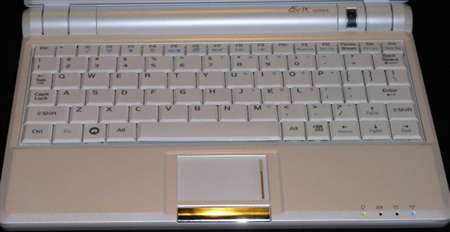Good things come in small packages
The Asus Eee PC challenges many conventional assumptions about mobile computing. The daring, diminutive device combines a svelte subnotebook form factor with a unique Linux software platform and a budget-friendly price—factors that could make this unprecedented product a mainstream marvel. Last week, my colleague Jon described the Eee PC as game-changing: a characterization that we will put to the test in this review.
Tech specs
- CPU: 900 Mhz Intel Mobile Celeron
- Video: Intel GMA 900
- Display: 7" LCD widescreen at 800x480
- Storage: 4GB internal flash
- OS: Custom Xandros-based Linux
- RAM: 512MB
- Optical drive: None
- Networking: Atheros AR5007EG wireless, 10/100 ethernet
First impressions
The most striking characteristic of the Eee PC is its unbelievably small size. At 8.9" x 6.5" x 1.4" and approximately 2.03lb, the Eee delivers serious mobility. When closed, it's approximately the same size as a hardcover book. It's also very easy to tote around while it is open and can be comfortably held in only one hand. The exterior has a glossy, pearl-white finish that picks up fingerprints very easily, but seems a bit more dirt-resistant than the plain white finish of a MacBook. According to Asus, the Eee PC will eventually be available in a range of colors, including pink, green, and black.
The Eee battery is a round module that fits into the back underneath the screen between the two hinges. The battery fits tightly with no wiggling and can be removed by sliding two clasps simultaneously. The hinges for the lid are very big and seem sufficiently sturdy. The screen, which takes up only part of the lid, is flanked by two large speakers and is surrounded by a wide bezel. The 4GB Eee has an embedded 0.3 megapixel video camera which is built into the bezel above the screen.
The Eee has several vents on the bottom and one on the side. A panel on the bottom can be removed to provide access to the Eee's RAM, but opening the panel voids the warranty. Intrepid modders have already successfully replaced the built-in 512MB stick with 1GB.
When running, the Eee generates very little fan noise. After several hours of use, the machine gets very warm but can still be used comfortably on a lap. The Eee has a row of LEDs along the front-right side that indicate battery status, drive access, and wireless connectivity.
Keyboard and touchpad
The Eee keyboard is easily the device's most significant weakness. The keys are very small and are positioned too close together, which makes the keyboard feel cramped. The layout is also a bit odd, with all of the number keys placed one position to the left of where they should be. Despite the small size, I was able to touch-type on the keyboard right away. During the first few hours of use, I made many typing errors and frequently hit the wrong key. My accuracy gradually improved, and after several days of use I can now type on it almost as well as I can type on a regular laptop keyboard.
There are several mistakes that I still make on a regular basis. I often hit the Enter key when I'm trying to type an apostrophe, and I often hit the 2 key when I'm trying to hit the 1 key. The odd number placement is particularly frustrating if you have passwords that include numbers, because you can easily hit the wrong ones without even realizing it when typing into an obscured password field.
In addition to all of the regular letter, number, and symbol keys, the Eee keyboard has a full row of F keys that can be used to adjust volume and brightness or toggle WiFi when used with the Fn key to the right of the control key. The keyboard also has arrow keys in the expected place and a context menu key. On the Eee keyboard, the key that would usually be the Windows key on regular keyboards is decorated with a small house icon.
Like the keyboard, the Eee touchpad is very small and will require users to adapt a little bit. It took me a day of use to become accustomed to the Eee touchpad. At the bottom of the touchpad is a single bar that serves for both left and right click depending on which side is pressed. On most Linux distributions, you can simulate a middle-click by pressing both sides at once, but this is somewhat difficult to do on the Eee because its a single button. The touchpad also has standard support for tap-clicking and finger scrolling.






reader comments
0